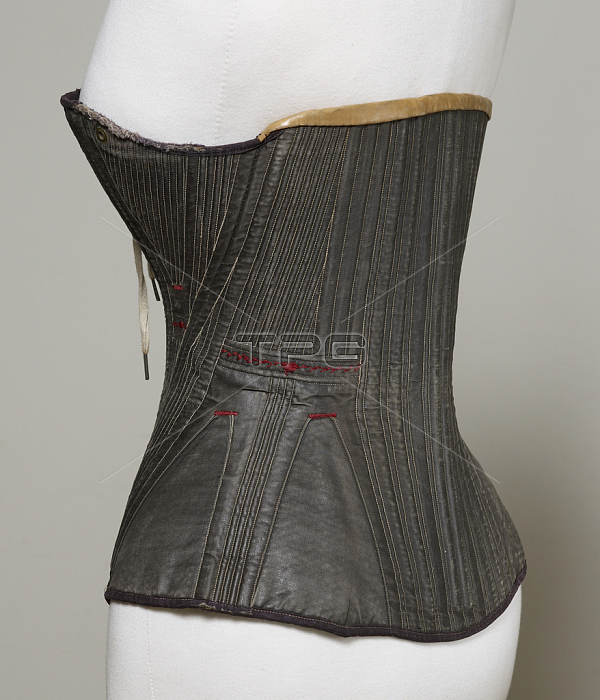
3073122 Corset (view D), 1840-50 (cotton, metal, leather & satin) by Unknown Artist, (19th century); height: 39 cm; Manchester Art Gallery, UK; (add.info.: Black cotton satin lined with khaki twilled cotton. Fronts each in one piece, shaped to bust by two gussets, two vertical and two diagonal bones, remainder quilted, front edges boned and laced through thirteen metal eyelet holes, metal eyelet hole at top edge; very straight back in one piece, shaped to hip by two gussets each side, fourteen vertical bones, remainder quilted; top edge cut away at underarm, bound with petersham at front and brown leather at back, lower edge bound with navy blue tape; leather patch at centre back inside hem; decorative red stitching along outside waistline and at base of gusset. Length (front) height: 39cm Length (back) height: 36cm Quilting is a craft or technique so old that its origins seem to stretch into deepest history. Basic quilting consists of two layers of outer fabric stitched over a lining of softer padding, although cord or thick thread can also be used to form the raised pattern. It was certainly known to the Romans, and the noun "quilt" is derived from the latin "culcita" meaning mattress filled with feathers or soft wool. In the Europe of the Middle Ages, quilting was much used for jerkins or vests worn under heavy armour, or as an actual padded lining to it. By the eighteenth century, quilted garments were popular for warmth and as protection against draughts. Women\'s decorative petticoats were particularly common, but also cloaks, caps and sleeveless bodices or jumps, as well as bed covers, men\'s waistcoats, children\'s caps and staybands and baby\'s robes. Some items were ready-made in workshops or by outworkers, particularly bed quilts and women\'s silk petticoats. The London Tradesman (1747) wrote that "quilted petticoats are made mostly by women, and some men, who are employed by the shops but earn little." Designs tended to be either simple geometrics like diamond panes, or more fluid stylised flowers, leaves and feathers; and cotton, linen or silk could provide the outer layer. Sometimes quilted pieces could also be printed or painted to add another decorative veneer, as in the main image from a quilted cloak. In essence, it is a technique which perfectly marries the decorative with the practical.); 穢 Manchester Art Gallery ; out of copyright.
| px | px | dpi | = | cm | x | cm | = | MB |
Details
Creative#:
TOP27510638
Source:
達志影像
Authorization Type:
RM
Release Information:
須由TPG 完整授權
Model Release:
No
Property Release:
No
Right to Privacy:
No
Same folder images:

 Loading
Loading